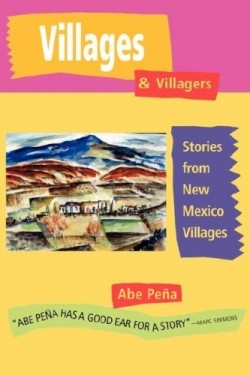Villages and Villagers
“In the villages we get up early. Old timers used to say, ‘Nos levantamos con las gallinas.’ We get up with the chickens,” the author writes. Residents and ex-residents of northwestern New Mexico will probably recognize, or even share, many of the names of those who settled the small town of San Mateo. In this, his second book, native-son Peña enriches and deepens the story of a band of pioneers who, in 1800, undertook the trek from the settlement of Albuquerque across wild country to occupy a land grant in what was essentially Indian country.
With the help of the U.S. Army, the area designated as the “Merced de Cevolleta” was settled by its thirty grantees, and just about the time Seboyeta was becoming a center of growth, a few families, attracted by vast grasslands on the side of Mount Taylor, gradually developed both sheep and cattle ranches. This later exodus collected settlers from the new area to form the village of San Mateo, the origin of most of the tales in the new book.
There’s no quicker way into the heart of a culture than to hear it retold in the voice of someone who’s been steeped in it since childhood, and former rancher and foreign service officer Peña has just that voice. Inserted throughout the book, stacks of photos back up his story to illustrate not only the life and times of the author, but chronicle a way of life and the changing environment that supports it.
Any story that follows the development of a new community, from its first straggling pilgrims, through the establishment of schools, local government, and plans for work and recreation, is going to have its sorrows, its minor and major tragedies, and its petty squabbles, but on the whole this is a jolly book, and among its jolliest parts are the many “dichos” (pithy statements in traditional language, often rhymed) bandied about daily by the population and often quoted in the local news, a custom with Hispanic roots that creates laughter with a touch of wisdom and often a heavy dose of sarcasm.
Early in the book there’s a chapter devoted to local usage, which sets a tone that pervades daily life, family values, and a community level that combines respect for everyone and a humorous approach to the fallibility of personal endeavor. “No hay atajo sin trabajo (There’s no herd without sweat)” warns that ranching doesn’t just happen, and that “de los dos no se hace uno” (referring to the fact that two incompetents don’t add up to one good worker).” These “dichos” are part of daily life wherever Spanish is spoken, with a history that extends back beyond Ferdinand and Isabella and will no doubt carry forward a love of life and language to the last Hispanic community on the last frontier in the world.
Disclosure: This article is not an endorsement, but a review. The publisher of this book provided free copies of the book to have their book reviewed by a professional reviewer. No fee was paid by the publisher for this review. Foreword Reviews only recommends books that we love. Foreword Magazine, Inc. is disclosing this in accordance with the Federal Trade Commission’s 16 CFR, Part 255.

